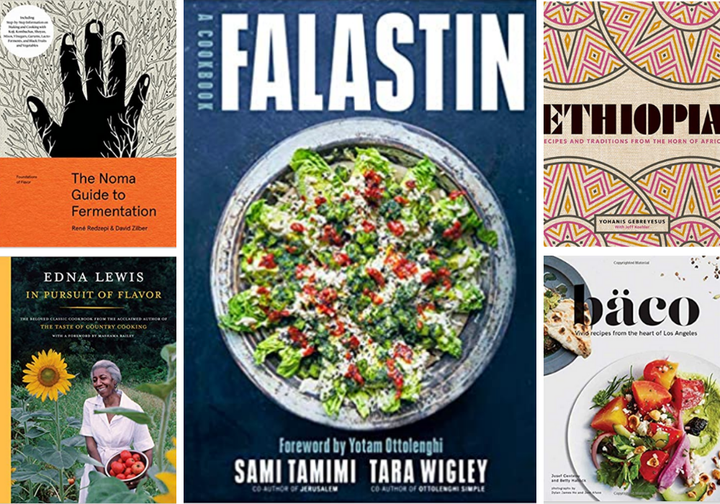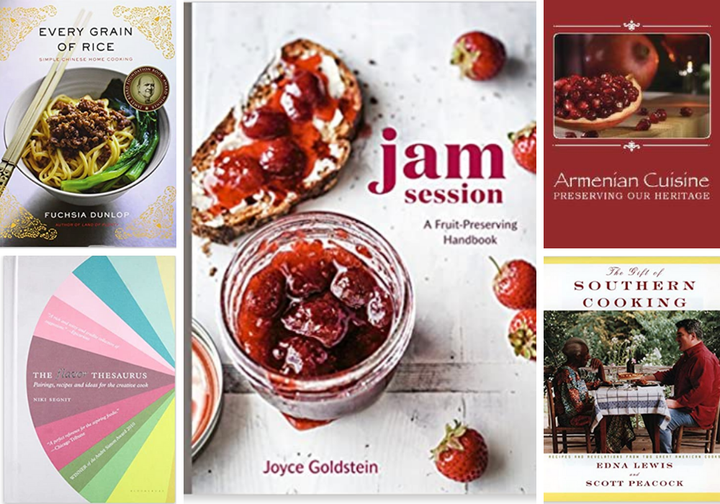After days of staring at co-workers over Zoom and nights wide-eyed in front of endless streaming television binges, it feels good to open a cookbook instead of mindlessly scrolling to the latest viral recipe. But beyond the break from screen time, cookbooks offer an analog advantage of allowing cooks to really dive in deeply to a place, concept, genre or even the mind of another person. Compared to a single recipe on a blog post, a book offers a culinary narrative.
We asked people from around the food world ― chefs, cooks, food photographers, writers and editors ― to tell us which cookbooks they have been turning to as they figure out how to cook their way through social isolation.

Paula Forbes, creator of Stained Page News, the internet’s source for cookbook news
“Paula Wolfert is one of my all-time favorite cookbook authors, and as I’ve been trying to eat healthier recently, I treated myself to one of her titles I didn’t already own: ‘Mediterranean Grains and Greens.’ In the 1998 book, Wolfert ― whose books are notoriously well-researched and detailed ― travels the shores of the Mediterranean, offering a myriad of approaches to staples I have in my pantry (grains) and the only thing I’ve managed to keep alive in my vegetable garden (that would be greens). In other words, it’s perfect for pandemic cooking.”
José Ralat, taco editor at Texas Monthly and author of “American Tacos”
“Although I know how to cook, I don’t do much cooking at home. My wife cooks ― and I eat everything she makes. Because we want to support local restaurants, almost all of which are independently owned, we’ve gotten a lot more takeout since the pandemic started. That being said, I recently got a copy of ‘The Flavor Thesaurus,’ and it’s blowing my mind.
“The 10-year-old book written by British food writer Niki Segnit pairs flavors in an encyclopedic fashion. The first entry, Chocolate and Almond, begins with, ‘What does parental guilt taste like?’ Each entry includes a quippy musing ― almost always unabashedly Eurocentric ― with an example of how the food relates to the cuisines of former European colonies. Usually those colonies are India and Indonesia, but Mexico makes an appearance for tacos al pastor, mole and others.
“Recipes are written into the entries much like in early cookbooks, as narratives. It’s a smart, fascinating book for its insight into flavor combinations and the interconnectivity of our gastronomic traditions. Peanuts are everywhere! It’s also humorous for its lack of self-awareness in the world and as a relic that retains significance. In the time of COVID-19 and the march toward racial justice and equity, ‘The Flavor Thesaurus’ is an excellent example of how far we have come and how much farther we need to go. Still, it’s problematic. The analogy used in the Lime and Chili entry doesn’t sit right with me. It begins: ‘Diego Rivera and Frida Kahlo. This turbulent twosome brings fervor to a vast range of Mexican dishes.’ Uff.”
Hali Bey Ramdene, founder of StudioHaliBey, a media consultancy focusing on food, wellness and lifestyle stories
“Information comes at you fast on the internet but with cookbooks, you get to settle into a moment. This was supposed to be a year of travel for me, so I’m reading cookbooks from all the places I want to be: ‘Bäco’ by Josef Centeno, ‘Falastin’ by Sami Tamimi and the old ‘Best of Gourmet’ cookbook. Because just as much as I want to travel, home is always an included destination for me.”

Maya-Camille Broussard, chef and owner of Justice of the Pies in Chicago
“The cookbooks that I love are by Edna F. Lewis, one of the first Black women from the South who wrote cookbooks that didn’t hide her real name, race or gender. Edna, as a Southern cook, a teacher, and a lecturer, has been an immense inspiration for me because I see so much of my journey in the kitchen in hers as well. My go-to cookbooks authored by Ms. Lewis are ‘The Gift of Southern Cooking’ and ’In Pursuit of Flavor.’”
Tiffany Ran, cook and pop-up operator of Ba Ba Lio
“The book I’ve been turning to a lot these days is ‘Pei Mei’s Chinese Cook Book, Volume 1.’ Fu Pei Mei is Taiwan’s Martha Stewart and the first edition of this cookbook published in [the 1960s] was Taiwan’s first colored recipe book. Fu Pei Mei’s book and cooking show helped to preserve and spread Chinese cuisine throughout Taiwan and bring the cuisine to an international stage. This is also the book that most young brides or international students would receive from their mothers as a way to carry a taste of home with them. I found this book for a steal at a used bookstore. It was well used before I acquired it. The English translation of this book can be a bit clunky at times, but something about that is really charming and comforting to me. Especially being away from home during the pandemic, it’s rare to have a cookbook that gives you a sense of cooking with your mother.”
Liana Aghajanian, journalist and author of “Dining in Diaspora”
“The cookbook that I’ve sought out and cooked from most during this pandemic is one called ‘Armenian Cuisine: Preserving Our Heritage,’ published by the Women’s Guild of St. John Armenian Church in Southfield, Michigan. This church cookbook is very special to me because I know many of the women whose recipes appear in it. In fact, if the pandemic had not happened, I would be cooking with them right now, because every year between March and September, the Women’s Guild of the church gets together almost every week to bake and cook a plethora of goods in preparation for the annual Armenian bazaar that takes place in October. To say that I’ve missed them and their immense culinary knowledge and camaraderie is an understatement. Most are third-generation descendants from Armenian genocide survivors continuing on their food traditions of their parents and grandparents, and being with them, cooking with them, goes beyond the food for me ― it’s a race against time to capture and document their skills before they’re lost. It’s been a privilege to learn from them, and not being able to be together has been upsetting. So instead I’m cooking the recipes that they’ve contributed in the book, at home alone. I’ve made different breads, filo dough pastries, pilaf, kebab, yogurt-based dishes and more. I’m grateful that they’ve preserved their work in this book so that even when I don’t get to see them, they’re with me in these recipes.”
Tara Austen Weaver, author of “Orchard House” and “Growing Berries and Fruit Trees in the Pacific Northwest”
“I’ve been cooking a lot from ’Every Grain of Rice.’ The food is just so good ― better than my local Chinese restaurants, and completely unlike what I normally cook. Especially in the beginning of quarantine, it was something to look forward to at the end of the day.”
Chandra Ram, editor of Plate
“It’s really helped me to create a bit of structure during this otherwise endless, weird time, so having a big cooking project on the weekend helps ― it gives me something to research, plan for and write lists about. And, cooking through some of the cookbooks stacked on my shelves and on my desk has basically become our new date night for me and my husband. One of the books on repeat lately is ‘Ethiopia: Recipes and Traditions From the Horn of Africa,’ by Yohanis Gebreyesus. I’ll be honest, I keep returning to it because I haven’t been able to nail the recipes the way I’d like to, especially injera. I’m on round five of trying to make it, and it’s just not right. And sometimes, it’s terrible. The first couple of rounds, I cooked it at too high a heat, making it crispy like the dosa I’m used to making. Then I got the cooking temp down, but the batter was too heavy and lacked that bubbly structure I love about injera. So, I keep going back to it and am taking the time to really get to know the batter and its quirks. If life was normal, I would plan to keep at it, but then would be distracted by weekend trips away, dinners out and vacations. But stuck in my apartment week after week, I can take the time to try and master injera, and let my actions follow my intentions.
“Along the same lines, I have ’Jam Session’ by Joyce Goldstein on my kitchen counter all the time. Normally I swing by the farmers market quickly before going to the office, and a few days later, try to figure out what to do with all that fruit turning soft on my countertop. Now, I can walk to the local market for a quick work break, and set up my computer in the kitchen so I can write next to pots of fruit bubbling into jam. And I can work out my frustration while forcing black raspberries through a food mill to get rid of all those annoying seeds. If ― fingers crossed ― life starts to return to normal next year, I’ll have a shelf or two of jams as my reward for staying in.”
Celeste Noche, food photographer
“My partner and I have been leaning on the new ’Joy of Cooking’! It’s the only cookbook that lives on our counter and has wrinkled pages and food stains as testaments for how much we use it. With everything going on, it’s been a real comfort to have an idea for something and know it’ll most likely be in Joy, versus combing through our other cookbooks or wading through blog posts on the internet. I love that the recipes are pretty straightforward and that there are so many variations. Our cats also always, ALWAYS sit on the book when we have it open to cook from, so it’s like we also have their approval ― just good and comforting vibes all around.”
Tristen Epps, executive chef, Red Rooster Overtown in Miami
“Like everyone on and off Instagram, my COVID kitchen included many loaves of sourdough, but that also inspired me to dig deeper into experimenting with fermentation. And no better place to draw from than ’The Noma Guide to Fermentation.’ I utilized a ton of chef Rene Redzepi’s techniques, including applying his lacto-fermentation method to white asparagus to enhance spring flavors and trying my hand at homemade miso using wild rice and black-eyed peas.
“Another book that became super relevant was ‘Toques in Black: A Celebration of Black Chefs.’ The book, curated by photographer Alan ‘Battman’ Batt, features recipes and stories from 101 Black chefs from across the country (including me). When the book was released in December, it felt monumental. It celebrates craft, cuisine and culture far beyond (but also including!) chicken and waffles. In June, when racial justice and equity came to the forefront of the conversation ― and while Black restaurant owners disproportionately struggled to secure the Paycheck Protection Program and other means of financial relief for their struggling businesses ― it solidified just how important this book really is. For people looking to learn about and support chefs of color, this is a great place to start.”